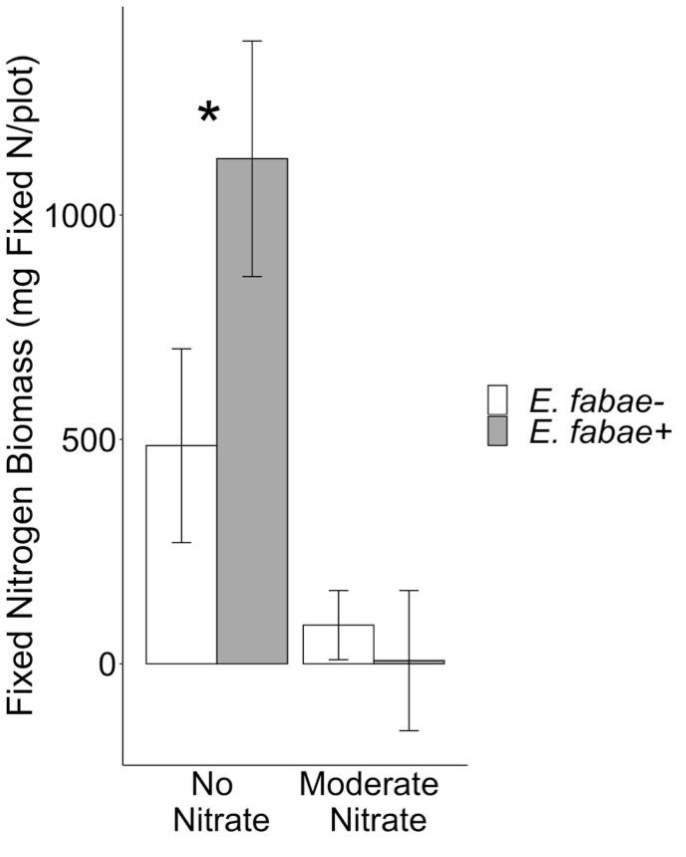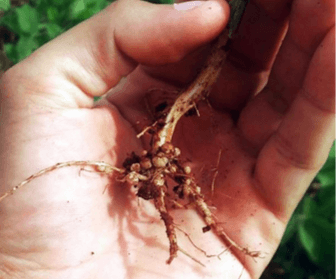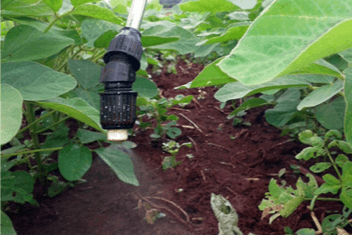Morgan N. Thompson & William O. Lamp
University of Maryland, Department of Entomology
Nitrogen is a critical nutrient for forage crop growth and quality. Typically, farmers need to apply additional nitrogen fertilizers to meet the nitrogen demand of crops. Nitrogen-fixing crops, however, do not require nitrogen fertilizer inputs, providing their own nitrogen supply through symbiotic interactions with soil microbes (rhizobia). Rhizobia induce the formation of root nodules in nitrogen-fixing crops, predominantly legumes, and extract inert nitrogen gas from the atmosphere to produce ammonium. In exchange for ammonium, legumes provide the rhizobia carbohydrates to fuel the microbe’s metabolism. Alfalfa is a leguminous forage crop that relies on symbiotic interactions with rhizobia to obtain nitrogen. As a perennial crop, alfalfa stands can last from 3-7 years and typically require no nitrogen fertilizer inputs, making alfalfa a sustainable and high-quality option for forage growers.
Pest pressure can decrease the economic viability of an alfalfa harvest. One particularly devastating pest of alfalfa in Maryland is the potato leafhopper (Empoasca fabae). Potato leafhoppers migrate northward from the southern United States every spring, making the timing of management in the northeast very difficult. Additionally, potato leafhoppers can utilize many alternative host plants, some of which are also of agroeconomic value, such as soybeans and several other fruit and vegetable crops, and leafhoppers can reproduce multiple times during the growing season. To protect alfalfa from potato leafhopper damage (termed ‘hopperburn’), insecticides are often the only option for growers. As a perennial crop, serious pest pressure in one growing season could impact nitrogen fixation in subsequent growing seasons, further accelerating economic losses for growers.

Therefore, in recent field and greenhouse experiments, we sought to determine the effect of potato leafhopper pest pressure on nitrogen fixation in alfalfa. We predicted pest pressure would negatively impact plant growth and carbohydrate production, resulting in reduced nitrogen fixation by rhizobia and uptake of fixed nitrogen by alfalfa. We also predicted losses in nitrogen content of alfalfa due to pest pressure could be offset by nitrogen fertilizer applications. To test our predictions in a field setting, we planted four combinations of small plots: 1) Fixing Cultivar + Nitrogen Fertilizer, 2) Non-Fixing Cultivar + Nitrogen Fertilizer, 3) Fixing Cultivar No Nitrogen Fertilizer, and 4) Non-Fixing Cultivar No Nitrogen Fertilizer. Fixing and non-fixing alfalfa cultivars were utilized to compare plants reliant on both nitrogen fixation and soil nitrogen with plants completely reliant on soil nitrogen. We split each plot in half, applying cages with leafhoppers to one side and cages without leafhoppers to the other. We analyzed the amount of fixed nitrogen in aboveground plant tissue. Results from the field experiment contradicted our predictions, showing nitrogen fertilizer did not increase aboveground nitrogen content of alfalfa under pest pressure. Nitrogen fertilizer (Moderate Nitrate) also decreased aboveground fixed nitrogen content in plants with and without pest pressure (Fig. 1). Unfertilized plants (No Nitrate), in contrast, showed significantly increased amounts of fixed nitrogen content when under pest pressure (Fig. 1). These results contradicted our predictions and suggest alfalfa interactions with rhizobia play a role in helping plants withstand pest damage.
We also examined leafhopper-alfalfa interactions in a greenhouse setting. Here, we analyzed the response of two different cultivars of alfalfa: leafhopper-susceptible (Pioneer 55V50) and leafhopper-resistant (Pioneer 55H94). Nitrogen fertilizer treatments were applied to both cultivars, as well as cages with or without leafhoppers. Results indicate that additional nitrogen fertilizer did not increase the percent nitrogen of plants under pest pressure, regardless of the cultivar (Table 1).
Overall, we conclude leafhopper pest pressure decreases total nitrogen content of alfalfa across all four cultivars tested in both field and greenhouse settings. Amending soils with additional nitrogen fertilizer did not offset losses to leafhopper pressure and we do not recommend this as a management strategy to growers. In our field experiment, however, we found evidence that leafhopper pressure enhances aboveground fixed nitrogen content of alfalfa grown in soils without additional nitrogen. Rhizobia may play an unexamined role in the response of alfalfa to leafhopper pressure. Broader implications of our results highlight how pest damage may increase nitrogen fixation, which may benefit farmers interested in utilizing nitrogen-fixing cover crops.
Acknowledgements: Many thanks to the Western Maryland Research and Education Center staff and greenhouse staff at the University of Maryland aiding in the execution of these experiments, as well as members of the Lamp Lab. This study was funded by Northeastern Sustainable Agriculture Research and Education (Award Number GNE18-187-32231) and the Hatch Project MD-ENTM-1802.


